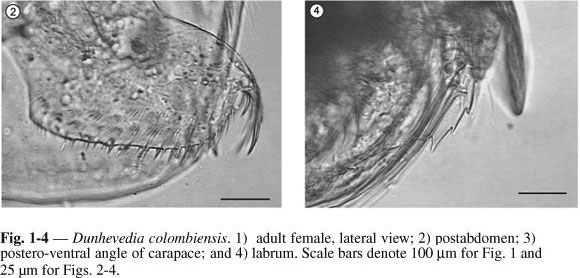NOTES AND COMMENTS
First record of Dunhevedia colombiensis Stingelin, 1913 (Cladocera, Anomopoda, Chydoridae) from Brazil
Lopes, P. M.I; Elmoor-Loureiro, L. M. A.II; Bozelli, R. L.I
ILaboratório de Limnologia, Universidade Federal do Rio de Janeiro, Prédio CCS, Bloco A, Subsolo, Sala A0-008, Ilha do Fundão, CEP 21941-590, Rio de Janeiro, RJ, Brazil
IILaboratório de Zoologia, Universidade Católica de Brasília, QS 7 lote 1, Bloco M, Sala 331, CEP 72030-170, Taguatinga, DF, Brazil
Correpondence to
According to Smirnov (1996), there are two species of the genus Dunhevedia (Crustacea, Cladocera, Anomopoda, Chydoridae) occurring in the Neotropics: Dunhevedia odontoplax Sars, 1901 and Dunhevedia colombiensis Stingelin, 1913. Although both species are widely distributed in the Neotropical Region, until now the single species known to exist in Brazil was D. odontoplax (Elmoor-Loureiro, 2000). This study reports the first Brazilian record of D. colombiensis, which was found in Cabiúnas Lagoon (Parque Nacional da Restinga de Jurubatiba, Macaé, Rio de Janeiro).
Samples were taken from the littoral zone of Cabiúnas Lagoon, located in Parque Nacional da Restinga de Jurubatiba (22° 18' S and 41° 42' W) in June 2004. D. colombiensis was found associated with the aquatic macrophytes Eleocharis interstincta, Potamogeton stenostachys, and especially with Typha domingensis. Samples of each macrophyte species were collected using a core sampler (Ø 20 cm). With the use of a 45 mm mesh plankton net, 10 L samples were concentrated and fixed immediately with 4% formalin.
The voucher specimens were deposited in the laboratory of limnology collection at the Universidade Federal do Rio de Janeiro and the zoology laboratory collection at the Universidade Católica de Brasília.
The observed specimens have elongated, almost rectangular shape; short rostrum; denticles at the postero-ventral angle of the carapace; postabdomen oval with anus located on its proximal dorsal margin (Figs. 1-3), which are typical features of the genus Dunhevedia. The presence of one large and three small teeth on the outer margin of the labral plate (Fig. 4) and two denticles on the postero-ventral angle of the carapace (Fig. 3) confirm the specimens as D. colombiensis.
Based exclusively on the number of labral teeth and carapace denticles, Stingelin (1913) described this taxon as a variety of Dunhevedia odontoplax. Smirnov (1996) elevated colombiensis to the species status, using the same characters to distinguish these two species. Nevertheless, the number of labral teeth and carapace denticles can vary within limits according to age, sex, and population, as Rajapaksa & Fernando (1987) noted for North American species of Dunhevedia.
A great overlap exists in geographical distribution. distribution between D. odontoplax and D. colombiensis. According to Smirnov (1996), D. odontoplax is found from Nicaragua to Chile, while D. colombiensis has been reported in Colombia and Argentina. So, the occurrence of D. colombiensis in Brazil, reported here for the first time, is not surprising.
On the other hand, the overlapping distri-butions of D. odontoplax and D. colombiensis, as well the variations possible in their diagnostic characters, suggests the need for more detailed morphological and ecological studies comparing these two species.
Acknowledgments The authors are grateful to Petrobrás, Projeto EcoLagoas, Conselho Nacional de Desenvolvimento Científico e Tecnológico (CNPq-PELD and CNPQ-PIBIC), and Instituto Brasileiro do Meio Ambiente e Recursos Naturais Renováveis (IBAMA).
REFERENCES
ELMOOR-LOUREIRO, L. M. A., 2000, Brazilian cladoceran studies: where do we stand? Nauplius, 8: 117-131.
RAJAPAKSA, R. & FERNANDO, C. H., 1987, Redescription of Dunhevedia serrata Daday, 1898 (Cladocera, Chydoridae) and a description of Dunhevedia americana sp.nov. from America. Canadian Journal of Zoology, 65: 432-440.
SMIRNOV, N. N., 1996, Cladocera: The Chydorinae and Sayciinae (Chydoridae) of the world. SPB Academic Publishing, Amsterdam, 197p. (Guides to the Identification of Microinvertebrates of the Continental Waters of the World, v. 1).
STINGELIN, T., 1913, Cladoceren aus den Gebirgen von Kolumbien. Mémoires de la Société Neuchâteloise des Sciences Naturelles, 5: 600-638.
Correpondence to:
Lourdes M. A. Elmoor-Loureiro
Laboratório de Zoologia
Universidade Católica de Brasília
QS 7 lote 1, Bloco M, Sala 331
CEP 72030-170, Taguatinga, DF, Brazil
e-mail: lourdes@ucb.br
Received August 8, 2005
Accepted August 18, 2005
Distributed November 1, 2006
Publication Dates
-
Publication in this collection
13 Apr 2007 -
Date of issue
Nov 2006



